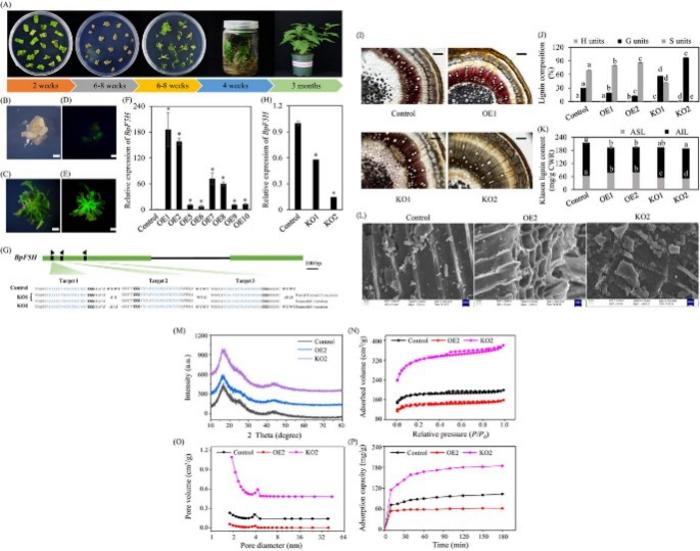Recent advancements in genetic engineering have significantly boosted the adsorption capabilities of lignocellulose-based porous carbon sourced from paper mulberry. By employing CRISPR/Cas9-mediated mutations, researchers successfully altered the lignin composition of paper mulberry, resulting in enhanced material properties. Specifically, knockout lines of the ferulate-5-hydroxylase (F5H) gene exhibited increased microporosity and superior adsorption capacity for methyl orange compared to control and overexpression lines, showcasing the industrial potential of these genetically engineered materials.

Credit: Horticulture Research
Recent advancements in genetic engineering have significantly boosted the adsorption capabilities of lignocellulose-based porous carbon sourced from paper mulberry. By employing CRISPR/Cas9-mediated mutations, researchers successfully altered the lignin composition of paper mulberry, resulting in enhanced material properties. Specifically, knockout lines of the ferulate-5-hydroxylase (F5H) gene exhibited increased microporosity and superior adsorption capacity for methyl orange compared to control and overexpression lines, showcasing the industrial potential of these genetically engineered materials.
Lignocellulosic biomass, such as paper mulberry, holds promise for sustainable material production due to its cost-effectiveness and renewability. However, optimizing lignin composition remains challenging due to its complex structure and varied composition, impacting the efficiency and quality of resulting porous carbon materials. Addressing these challenges requires further exploration into genetic modifications that can refine lignin composition, unlocking the full potential of lignocellulosic biomass for high-value industrial applications.
A recent study (DOI: 10.1093/hr/uhae124) by researchers from the University of Jinan and the Chinese Academy of Sciences, published on April 23, 2024, in Horticulture Research, investigates the effects of CRISPR/Cas9-mediated mutations in the F5H gene on the adsorption capacity of lignocellulose-based porous carbon derived from paper mulberry.
This study focused on genetically modifying the F5H gene in paper mulberry to enhance its lignin composition and improve the adsorption capacity of the resulting porous carbon. Researchers created overexpression (OE) and knockout (KO) lines, resulting in transgenic plants with varied lignin structures. The KO lines exhibited increased micropores and significantly improved adsorption capacity compared to control and OE lines. Specifically, the KO2 line demonstrated a 3.3-fold increase in guaiacyl (G) units and the highest surface area among all samples, leading to superior adsorption performance for methyl orange. These results highlight the potential of CRISPR/Cas9 technology to optimize lignin composition, paving the way for advanced material applications and enhancing the utility of lignocellulosic biomass.
Dr. Chunxiang Fu, one of the lead researchers, emphasized, “Our findings underscore the vast potential of genetic engineering in refining lignin composition for advanced material applications. By harnessing CRISPR/Cas9 technology, we can tailor lignocellulosic biomass properties, opening new avenues for sustainable and high-performance materials.”
The study’s outcomes demonstrate the feasibility of using CRISPR/Cas9-mediated genetic modifications to enhance lignocellulosic biomass-derived materials. This approach not only improves the adsorption capacity of porous carbon but also lays the groundwork for developing high-value bioproducts from other woody plants, potentially revolutionizing bioengineering and material science fields.
###
References
DOI
Original Source URL
Funding information
This work was supported by the Taishan Scholar Program of Shandong (to C.F.), the National Natural Science Foundation of China (Nos. 32300320 and 32270368), the Natural Science Foundation of Shandong Province, China (2021ZDSYS29), and Qingdao New Energy Shandong Laboratory of KeyProjects Programs (QNESL KPP202302).
About Horticulture Research
Horticulture Research is an open access journal of Nanjing Agricultural University and ranked number one in the Horticulture category of the Journal Citation Reports ™ from Clarivate, 2022. The journal is committed to publishing original research articles, reviews, perspectives, comments, correspondence articles and letters to the editor related to all major horticultural plants and disciplines, including biotechnology, breeding, cellular and molecular biology, evolution, genetics, inter-species interactions, physiology, and the origination and domestication of crops.
Journal
Horticulture Research
Subject of Research
Not applicable
Article Title
CRISPR/Cas9-mediated mutation of FERULATE 5-HYDROXYLASE enhances adsorption capacity of lignocellulose-based porous carbon from paper mulberry
Article Publication Date
23-Apr-2024
COI Statement
The authors declare that they have no competing interests.



